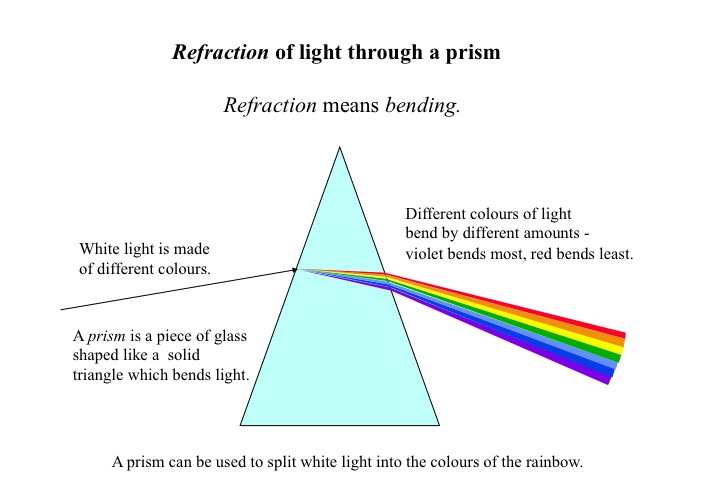
The World Lighthouse Hub
H02: Light

Figure H02: A ray of light entering from the left is diverted through a prism, but the different colour components in the light are diverted by different amounts, and so the light that emerges from the prism is coloured.
Q: What is Light?
Light is pure energy. It travels from place to place at an absolutely fantastic speed - 300,000 kilometres per second or 186,000 miles per second! There is nothing that can travel faster than light: nothing can even approach this speed. Even the fastest spacecraft we use today travel at only about 30 kilometres per second. For everyday purposes, on Earth, we say that light travels "instantaneously" from one place to another.
Another property of light is that, for all general purposes, it travels from one point to another in a straight line. This is a very important property that we will use extensively in our discussions later. There are circumstances in which light can bend. It looks like light has been bent by passing through the prism in Figure H01, but if you look carefully, you will see that what has really happened is that the light has changed direction on passing from air to glass, and from glass back to air again. The rays of light themselves are straight lines. Light is affected by gravity, and bends when it passes through strong gravitational fields, but this is beyond the scope of our discussions here.
We all know that light has colour; this is shown in Figure 1. Thus, white light is made up of a wide range of different coloured light. In simple terms we think of white light as being made up of the colours of the rainbow. A rainbow occurs in nature when the rays of sunlight pass through water droplets in the air; rainbows occur when the sun comes out immediately after a heavy shower of rain and when you, the observer are looking into the rain shower with the sun at your back.
Precisely, we can express the relationship between frequency, wavelength, and speed of light as:
frequency (f) x wavelength (l) = speed of light (c)
Because the speed of light is always constant, as the wavelength gets bigger, the frequency gets smaller and vice versa. At one end of the spectrum, red light has long wavelength and, at the other end, violet light has short wavelength. Conversely, red light spans lower frequencies than violet which occurs at higher frequencies.
We shall discuss further the importance of the different colours of light to the use of lighthouses but for the moment we shall consider only white light.